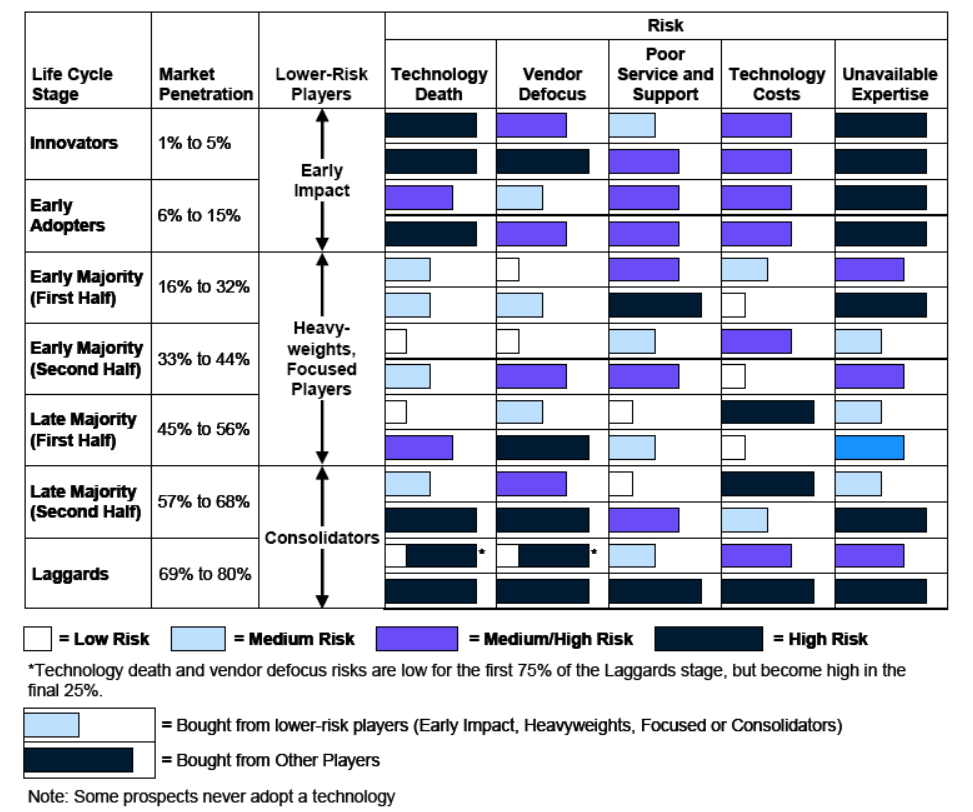The Enterprise Technology Architecture, Part 3
In technology, just as in business in general or even life, there are risks that we all take. Whether it’s skydiving, investing in a new startup or implementing new technology, there are always risk that need to be evaluated and weighed. Each area of society has it’s own specific risks, and within the technology field, it is no different. Risks that are common with technology tend to fit into these categories:
- Scalability – Will my technology be able to handle the scope that I need now as well as grow to fit the scope in the future?
- Longevity (Vendor Defocus) – Will my technology continue to be efficient and supported in the future or will it need to be quickly replaced by new technology?
- Failure to meet Expectations (Technology Death) – Will new technology I acquire actually meet my needs?
- Lack of Support – Will the vendor/developer be able to support my needs?
- Lack of Expertise – Are there resources available to acquire which can internally support the technology for the long-term?
- Cost of Technology – Will the cost of buying and using technology becomes unaffordable?
- Data Integrity & Security – How do I keep my data safe and prevent data corruption?
- General Technology Security – Aside from data, how do I keep the rest of my technology secure? This includes malware and viruses.
- Redundancy – Do I have the necessary backup systems in place to keep my business functioning?
- New Technology Adoption – How do I know when to implement something new? What will be the positive and negative outcomes of the adoption?
As I talked about previously in How Do You Adopt?, the adoption of innovation breaks down into 5 basic categories:
- Innovators – 2.5% of the population.
- Early Adopters – 13.5% of the population.
- Early Majority – 34% of the population.
- Late Majority – 34% of the population.
- Laggards – 16% of the population.
As pointed out by Mike Blechar of Gartner, the technology risk level is directly dependent on the type of adopter involved (Blechar, 2006). This is also directly related to the vendor from which the technology is purchased. Blechar used 5 similar categories to differentiate vendors which correspond to the same category if adopters:
- Early Impact Players
- Other Players
- Heavyweights
- Focused Players
- Consolidators
Bechar goes on to detail how adopters and vendors interact:
During the technology’s first two life cycle stages (Innovators and Early Adopters), the vendors in the market will be Early Impact Players and Other Players. As the market matures and technology enters the Early Majority stage of the life cycle, vendors that are Early Impact Players transform into Heavyweights or Focused Players. Some Other Players will disappear during the Early Majority stage, and a few may be able to become Focused Players or Heavyweights. As the Early Majority stage progresses, and to the end of the first half of the Late Majority stage, vendors may move between different classifications. Heavyweights may become Focused Players or disappear, and Focused Players may become Heavyweights or disappear. The risks of buying from Other Players that survive to the end of the first half of the Late Majority stage will remain high.
Another change happens as the technology moves into the second half of the Late Majority stage. By now, the market is approaching saturation and is beginning to consolidate. Some vendors that are Heavyweights and Focused Players will exit the market (particularly during the final Laggards stage of the technology life cycle); other vendors will be acquired or will merge to become Consolidators. As the technology life cycle draws to a close, the majority of vendors left in the market will be Consolidators. These will be the vendors that have the largest and most stable maintenance revenue and, in terms of technology risk, are the “best bets.” The technology risks associated with Other Players that survive into the second half of the Late Majority and Laggard stages are now at their highest.
The severity of the risks will change for the vendors as the technology life cycle of adoption progresses. Understanding how the risk levels change throughout the technology life-cycle can help potentially mitigate those risks by proactively addressing them.
Image Source: Blechar, 2006
References:
Blechar, Mike. (2006). Managing Technology Life Cycle Risks. (G00142109). Gartner.

